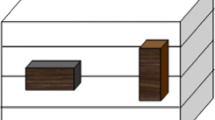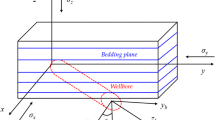Abstract
Serious wellbore instability occurs frequently during horizontal drilling in shale gas reservoirs. The conventional forecast model of in situ stresses is not suitable for wellbore stability analysis in laminated shale gas formations because of the inhomogeneous mechanical properties of shale. In this study, a new prediction method is developed to calculate the in situ stresses in shale formations. The pore pressure near the borehole is heterogeneous along both the radial and tangential directions due to the inhomogeneity in the mechanical properties and permeability. Therefore, the stress state around the wellbore will vary with time after the formation is drained. Besides, based on the experimental results, a failure criterion is verified and applied to determine the strength of Silurian shale in the Sichuan Basin, including the long-term strength of gas shale. Based on this work, horizontal well borehole stability is analyzed by the new in situ stress prediction model. Finally, the results show that the collapse pressure will be underestimated if the conventional model is used in shale gas reservoirs improperly. The collapse pressure of a horizontal well is maximum at dip angle of 45°. The critical mud weight should be increased constantly to prevent borehole collapse if the borehole is exposed for some time.












Similar content being viewed by others
Abbreviations
- B :
-
Skempton’s coefficient, nondimensional
- E :
-
Young’s modulus in the plane of isotropy, GPa
- E′:
-
Young’s modulus normal to the isotropic plane, GPa
- K :
-
Permeability of shale reservoir, nD
- P C :
-
Collapse pressure of the shale gas horizontal wellbore, g/cm3
- P p :
-
The near-wellbore pressure, g/cm3
- SG:
-
The equivalent density of pressure (i.e. specific gravity), g/cm3
- t :
-
Loading time in rock mechanics testing, days
- UCSC :
-
Corrected uniaxial compressive strength of shale, MPa
- UCSF :
-
Fitted uniaxial compressive strength of shale, MPa
- UCSi :
-
Instantaneous UCS of shale, MPa
- UCSt :
-
Long-term UCS of shale, MPa
- UCST :
-
Test uniaxial compressive strength of shale, MPa
- VTI:
-
Transversely isotropic medium with vertical axis of symmetry
- α :
-
Effective stress coefficient, nondimensional
- μ :
-
Fluid viscosity, mPa s
- σ h :
-
Minimum horizontal in situ stress, MPa
- σ H :
-
Maximum horizontal in situ stress, MPa
- σ V :
-
Overburden in situ stress, MPa
- υ :
-
Poisson’s ratio in the plane of isotropy
- υ′:
-
Poisson’s ratio in the plane normal to the isotropic plane
References
Abousleiman Y, Roegiers JC, Cui L (1995) Poroelastic solution of an inclined borehole in a transversely isotropic medium. In: Proceedings of the 35th U.S. Symposium on Rock Mechanics, Lake Tahoe
Amadei B, Pan E (1996) Importance of anisotropy when estimating and measuring in situ stresses in rock. Int J Rock Mech Min Sci Geomech Abstr 33(3):293–325
Avass H, Shebatalhand A, Khan M (2006) Wellbore instability of shale formation Zuluf field. SPE Technical Symposium of Saudi Arabia Section Dhahran. Society of Petroleum Engineers, Saudi Arabia
Carcione JM (2007) Wave fields in real media–wave propagation in anisotropic, anelastic and porous media. Pergamon, Amsterdam, p 145
Ĉervenŷ V (2001) Seismic ray theory. Cambridge University Press, Cambridge, pp 78–82
Chen G, Ewy RT (2002) Investigation of the undrained loading effect and chemical effect on shale stability. Rock Mechnics Conference. Society of Petroleum Engineers, Irving
Chen YM, Kuo MC (2001) A failure criterion for transversely isotropic rocks. Int J Rock Mech Min Sci 38(3):399–412
Cui L, Abousleiman Y, Cheng AHD (1999) Time-dependent failure analysis of inclined boreholes in fluid-saturated formations. J Energy Resour ASME 121(1):31–39
Cui SH, Ban FS, Yuan GJ (2011) Status quo and challenges of global shale gas drilling and completion. Nat Gas Ind 31(4):1–3
Detournay E, Cheng AHD (1993) Fundamentals of poroelasticity. Pergamon, Oxford, pp 113–171
Ewy RT, Bovberg CA (2010) Strength anisotropy of mudstones and shales. In: The 44th US Rock Mechanics Symposium and 5th U.S.-Canada Rock Mechanics Symposium. American Rock Mechanics Association, Salt Lake City
Fa L, Castagna JP, Zeng ZW (2010) Effects of anisotropy on time-depth relation in transversely isotropic medium with a vertical axis of symmetry. Chin Sci Bull 55(21):2243–2251
Helbig K (1994) Fundations of elastic anisotropy for exploration seismics. Pergamon, Oxford, pp 56–60
Huang RZ, Zhuang JJ (1986) A new fracturing pressure prediction method. Oil D&P Tech 8(3):1–3
Jaeger JC, Cook NGW, Zimmerman R (2007) Fundamentals of rock mechanics, 4th edn. Blackwell, Oxford, pp 80–84
Lee YK, Pietruszczak S (2008) Application of critical plane approach to the prediction of strength anisotropy in transversely isotropic rock masses. Int J Rock Mech Min Sci 45(4):513–523
Low YS, Jin YQ (2006) Rock Mechanics and Petroleum Engineering. Petroleum Industry Press, Beijing, p 84 (in Chinese)
McLamore RT (1967) A strength criterion for anisotropic rocks based upon experimental observations. In: 96th Annual AIME Meeting. Los Angeles, California, Society of Petroleum Engineers
Oliver G, Florian K, Jeroen J (2012) Comparison between analytical and 3D finite element solutions for borehole stresses inanisotropic elastic rock. Int J Rock Mech Min Sci 51:53–63
Rüger A (2002) Reflection coefficients and azimuthal AVO analysis in anisotropy media, geophysical monograph series. Society of Exploration Geophysicists, Tulsa
Safdar K, Sajjad A, Han HX (2011) Importance of shale anisotropy in estimating in situ stresses and wellbore stability analysis in horn river basin. In: Canadian unconventional resources conference. Society of Petroleum Engineers, Canada
Shaikh AA, Pritish M, Salsh AA (2011) Using integrated geomechanical study to resolve expensive wellbore Stability problems while drilling through the zubair shale/sand sequence of Kuwait: a case study. Society of Petroleum Engineers, Muscat
Tan T (1982) The mechanical problems for the long-term stability of underground galleries. Chin J Rock Mech Eng 1(1):1–20
Tan Q, Deng JG, Yu BH (2010) Wellbore instability and countermeasures in offshore bedding shale formations. Petrol Sci Technol 17(5):1712–1718
Tien YM, Kuo MC, Juang CH (2006) An experimental investigation of the failure mechanism of simulated transversely isotropic rocks. Int J Rock Mech Min Sci 43(8):1163–1181
Tsvankin I (2001) Seismic signatures and analysis of reflection data in anisotropic media. Geophysics 69(2):576–582
Vutukuri VS, Lama RD, Saluja SS (1974) Handbook on mechanical properties of rocks—testing techniques and results, vol 3. Trans Tech, Clausthal, pp 105–115
Walls JD (1991) Measured and calculated horizontal stresses in the travis peak formation. SPE J 9(4):259–263
Yu BH, Deng JG, Yan W (2010) Borehole sloughing control in shale formations. Petrol Dri Tech 38(1):56–58
Zhang ZM (1993) Structural mechanics of composite material. Beihang University Press, Beijing, pp 56–60
Zhong SY, Ma MJ (1987) An approach to creep failure regularity of weak rock. J Cent South Inst Min Metall 18(5):495–500
Zoback MD (2007) Reservoir geomechanics. Cambridge University Press, New York, pp 123–139
Zou CN, Dong DZ, Wang SJ (2010) Geological characteristics, formation mechanism and resource potential of shale gas in China. Petrol Explor Dev 37(6):641–651
Acknowledgments
This work is supported by the National Science Fund (project no. 51174219), the National Science Fund Innovative Research Groups (project no. 51221003), and the National Science and Technology Major Project (project no. 2011ZX05009-005).
Author information
Authors and Affiliations
Corresponding author
Rights and permissions
About this article
Cite this article
Yuan, JL., Deng, JG., Tan, Q. et al. Borehole Stability Analysis of Horizontal Drilling in Shale Gas Reservoirs. Rock Mech Rock Eng 46, 1157–1164 (2013). https://doi.org/10.1007/s00603-012-0341-z
Received:
Accepted:
Published:
Issue Date:
DOI: https://doi.org/10.1007/s00603-012-0341-z




